Posted by Elena del Valle on August 4, 2010
By Harald H. Vogt
Founder and chief marketer, Scent Marketing Institute

Harald H. Vogt, founder and chief marketer, Scent Marketing Institute
Photo: Scent Marketing Institute
This just in: A group called “Teens turning Green” chimes in on the safety (better, the lack thereof) of fragrances in consumer goods, body care products and fine fragrances that people buy to enjoy – or simply to smell better.
As sure as the kids go to camp, every summer the scent-adverse special interest groups pick up reports from organizations such as “The Campaign for Safe Cosmetics” that lament the fact that there are health risks resulting from “secret chemicals” in fragrance. Usually such advocacy groups are also anti-commerce and against aggressive marketing. At least with TTG that isn’t the case since they sell their own range of products via their web site while they criticize the products of others right next door. For just $130 the whole range can be yours’…
Click here to read the entire article Transparency – the new consumer demand
Posted by Elena del Valle on August 2, 2010

Debt as Percent of GDP – click to enlarge
These days everybody is talking or thinking about debt. The debt of the United States is a concern for many as our country falls deeper into debt to pay off wars and save banks, mortgage companies, car makers and the like from supposed failure. On the other side of the pond European nations like Greece, Portugal, Spain, Italy, and Ireland have been in the news lately due to their precarious debt related status.
The debt of nations is but one part of the problem. Across the west companies and individuals have over extended themselves, borrowing, some believe irresponsibly, in search of ever higher returns in the case of greedy companies and investors. Consumers have gotten into debt to buy bigger cars, houses, trips and some of the many trappings of today’s consumer driven society.
According to a recent an article in The Economist relying on data from the McKinsey Global Institute Ireland and Iceland approached the debt limit of eight and as much as ten times their gross domestic product (GDP). They are the the most noteworthy but not the only ones.
British bank debt as it relates to the country’s economy is significant as is the level of debt of corporations in Spain. The relationship between public and private sectors and debt issues is complex. If the government is needed to hold up companies with too much debt it will have an impact on countries with economies that appear healthy or less at risk than that of their neighbors.
Among countries with high debt to GDP ratios and a worsening outstanding debt compared to economic growth according to the article, Spain has surpassed Greece as the country in the worst position.
What does this mean to the average person in North America and Europe? Debt has caught up with governments, companies and consumers. Things are changing. No spending or cautious spending has replaced over-the-top spending. But astute observers say the many decades of living now with the promise to pay later will have a long term effect. Government promises and private sector conservatism now aren’t enough given that governments are having to come to the rescue of private sector behemoths and in many instances the countries themselves are in turbulent economic waters.
At the same time North America and many nations in Europe have large aging populations in varying proximity to their retirement years. That will mean fewer productive people in the workforce and more retirement dollars and healthcare dollars draining the system during belt tightening times. In all Organization for Economic Cooperation and Development (OECD) countries total spending on healthcare is rising faster than economic growth, causing the average ratio of health spending to GDP to rise 7.8 percent in 2000 to 9 percent in 2008. The causes behind the rising health spending, technological change, population expectations and population aging, are expected to continue to drive costs higher in the future.
In some countries the falling GDP and rising healthcare costs led to a marked increase in the ratio of health spending to GDP. For example, in Ireland, the percentage of GDP assigned to health increased from 7.5 percent in 2007 to 8.7 percent the following year while in Spain the increase was from 8.4 percent to 9 percent for the same years. In 2008, the United States spent $7,538 per person on health more than double the $3,000 average of all OECD countries. Although Norway and Switzerland, the next generous with healthcare budgets, spent 50 percent more than the OECD average.
The solution, some believe, is to grow economies while reducing spending. How will social benefit heavy societies like those in western Europe deal with growth requirements and the debt burden? Will they cut back healthcare, social and retirement benefits?
Entrepreneurs, an important source of future intellectual and financial wealth, may struggle since more than half of all new firms rely on debt finance, according to The Economist. Forward looking analysts indicate that to survive businesses will have to adapt to the economic situation and new mindset. In an ever tighter corporate environment with increased oversight and fewer entrepreneurial windows, it is likely marketers too will need to adjust to the new reality, demonstrating their worth with measurable results.
Posted by Elena del Valle on July 30, 2010

Playing the Lying Game
Photo: Gini Graham Scott, J.D., Ph.D.
Even though as individuals and members of society we frown on lying everybody lies, even animals. It is in our DNA to lie as a way to enhance our likelihood of surviving and thriving in a competitive environment, according to experts on lying. Not everyone lies as much as others, for the same reasons or to the same type people in their lives. How someone lies, to whom, why and how often are some of the distinguishing characteristics in the lying spectrum. Even the definition of a lie varies.
Many people may disagree about the definition of a lie. Is it a lie, for example, to use a marketing photo in a hotel brochure that makes a hotel look better than it does in real life? To rearrange furniture for the photo shoot in a way that shows only the prettiest side of a room? Is it a lie when someone doesn’t share all that he or she knows about something? In other words, when it comes to lying is omitting information the same as actually saying something the speaker knows not to be the truth?
In Playing the Lying Game Detecting and Dealing with Lies and Liars from Occasional Fibbers to Frequent Fabricators (Praeger, $44.95) Gini Graham Scott, J.D., Ph.D. explores lying, its history, motivations, the types of lies and liars and to whom they are told, and issues to consider when deciding whether to confront a liar. She also includes a simple lying self assessment questionnaire.
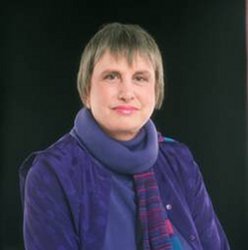
Author Gini Graham Scott, J.D., Ph.D.
The 211-page hardcover book published this year is divided into 14 chapters in four sections: Why Do We All Lie?, Identifying the Different Types of Liars, Lying in Public and Professional Life and Lying in Personal and Private Life. In the last chapter, Conclusion, the author suggests people are more likely to be comfortable interacting with others who have similar beliefs and attitudes about lying; she also addresses confronting a lie, confessing, getting caught, forgiveness and dealing with lies.
According to her biography, Graham Scott is a consultant and college instructor who has authored more than 50 books.

Click here to buy Playing the Lying Game
Comments:
Filed Under: Books
Posted by Elena del Valle on July 28, 2010
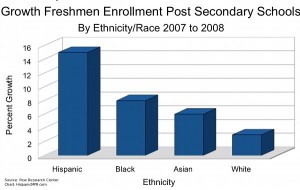
Freshmen Enrollment Growth by Ethnicity/Race – click to enlarge
What are young people in America to do during this recession? Enroll in college. There is a college boom taking place and it is being driven by minorities, according to a recent Pew Research Center
article based on the organization’s analysis of new data from the United States Department of Education.
There was an increase of 144,000 freshman students from the fall of 2007 to the fall of 2008, the first year of the recession, at the nation’s 6,100 post-secondary institutions representing a 6 percent increase, the largest in 40 years. Almost three-quarters of the growth was from minority freshmen.
From 2007 to 2008 although there was only a 3 percent increase in freshman college enrollment of whites, minority enrollment was noteworthy. Hispanics enrollment at post secondary institutions grew 15 percent, blacks enrollment grew 8 percent, and Asian enrollment grew 6 percent.
Of course the growth is not spread evenly across the country. Cities with historically large ethnic, especially Hispanic, populations may have markedly higher increases and an overall higher ethnic presence. An example is South Florida.
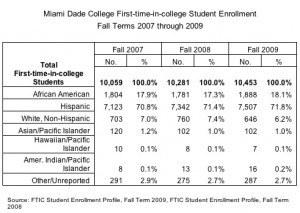
Click on image to enlarge
“MDC’s enrollment growth reflects the community we serve: more than 80 percent of Miami-Dade’s residents are racial or ethnic minorities, with Hispanics predominating. In the 2000 Census 57 percent of Miami-Dade County residents were Hispanic, increasing to 62 percent in the latest estimates. Hispanics at MDC have increased steadily as a proportion of overall student enrollment from 2007 through 2009, and even more so as a percentage of freshman enrollment,” said Margaret Mannchen, associate director, Institutional Research Operations, Miami Dade College, one of the largest post-secondary institutions in the country in both number of students enrolled (170,000) and number of associates degrees awarded
“Now Hispanics are about 72 percent of our first-time-in-college students. Looking at all credit students, we see both African American and White Non-Hispanic percentages declining slightly from Fall 2007 through Fall 2009. In 2009, however, the proportion of African American freshmen was starting to show an increase, after a slight decline in 2008.”
The growth is not surprising given the demographic profile of the United States. As the white population ages it is the minority youth that fuel the nation’s growth. In addition, Census Bureau surveys indicate the Hispanic high school completion rate reached an all-time high of 70 percent in October 2008, a 2.5 percent increase over 2007 and the largest increase of any ethnic or racial group.
Although in the past minority students tended to seek community colleges and trade schools, the growth from 2007 to 2008 was at all basic levels of post secondary education. At the same time, a lower percent of white freshmen enrolled in less-than-four-year schools in 2008 (53 percent) than in 2007 (55 percent); and in four-year schools in 2008 (62 percent) than in 2007 (64 percent).
Of course not all institutions of higher learning showed an increase for that time period. One private university in South Florida had a decrease in enrollment numbers.
“Unfortunately I don’t know that 2008 would be a good bench as nationally there was a decrease in overall enrollment due to the financial crisis and the availability of credit. The numbers picked up again sharply for 2009 and we are currently tracking for 2010 at about a 2-3% increase in enrollment. As I look at the applications coming in we are definitely seeing an increase in minority applications and matriculations,” said Andre Lightbourn, dean, Enrollment Management, Saint Thomas University in Broward County.
“According to our institutional fact book amongst the broad categories Black and Hispanic we are probably about flat for 2007, 2008 & 2009. The numbers have increased for foreigners and other ethnic groups. The number of white students has declined in the same period for the last three academic years 2007, 2008 & 2009.”
An executive summary of the Pew Research Center analysis, written by Richard Fry, was published June 16, 2010. The Pew Research Center, a self described nonpartisan provider of information on “the issues, attitudes and trends shaping America and the world.”
Posted by Elena del Valle on July 26, 2010

Hernandez, president and founder, Imagen Foundation and executive producer, Imagen Awards
Photo: Imagen Foundation
A podcast interview with Helen Hernandez, president and founder, Imagen Foundation and executive producer, Imagen Awards is available in the Podcast Section of Hispanic Marketing & Public Relations, HispanicMPR.com. During the podcast, Helen discusses the Foundation and 2010 Imagen Awards with Elena del Valle, host of the HispanicMPR.com podcast.
Prior to establishing the Imagen Foundation, Helen was the vice president of Public Affairs for Embassy Communications (now Sony Pictures Entertainment). As the major television production company’s local and national liaison, she was instrumental in developing and supervising corporate programs to enhance the company’s reputation in the national community for socially and culturally sensitive programming. Helen began her career as a labor union organizer for the United Furniture Workers of America.
To listen to the interview, scroll down until you see “Podcast” on the right hand side, then select “HMPR Helen Hernandez” click on the play button below or download the MP3 file to your iPod or MP3 player to listen on the go, in your car or at home. To download it, click on the arrow of the recording you wish to copy and save it to disk. The podcast will remain listed in the July 2010 section of the podcast archive.
Posted by Elena del Valle on July 23, 2010

La belleza de saber vivir book cover
Photo: Grupo Nelson
Barbara Palacios, Miss Universe 1986, banked on her beauty queen reputation to gain the attention of potential readers and fans for a Spanish language book she published recently in the United States. In La belleza de saber vivir 9 pasos para conducir tu vida (Grupo Nelson, $14.99) she shares insights about her philosophy of life and the importance of religion in her life.
The 224-page hardcover book is divided into nine chapters, one for each of the nine steps she proposes her readers follow to live a fulfilling and faith oriented life: La Aceptación, El Enfoque, El Equilibrio, El Liderazgo, El Optimismo, La Gratitud, El perdon, La Dignidad and La Fe. The chapters represent what she considers life’s important paths: acceptance, vision, balance, leadership, optimism, gratitude, forgiveness, dignity and faith.
According to her biography, Palacios’ business ventures include several advertising agencies. She also leads her own company, BP Group featuring her own line of jewelry, beauty products and several stores that bear her name across the United States. The motivational speaker lives in Miami with her husband and two sons.

Click here to buy La belleza de saber vivir (Spanish Edition)
Comments:
Filed Under: Books
Posted by Elena del Valle on July 22, 2010
Information provided by our Event Partner
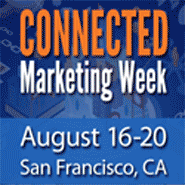
Connected Marketing Week (August 16-20)
San Francisco, California
August 16-20, 2010
ClickZ, in the first ever all digital marketing festival, has launched Connected Marketing Week (August 16-20 in San Francisco) bringing together the most important voices in email, search, social media, and advertising.
Over five themed days, Connected Marketing Week will play host to 6 education and training focused events including Ad Networks and Exchanges co-programmed by the IAB Networks and Exchanges Committee, Jeff Pulver’s 140 Character Conference, SES San Francisco, the Online Marketing Summit, and the E-mail Experience Council’s Optimization forum. Each conference will revolve around one key idea – how are and will brand advertisers engage with their customer’s online.
Register before July 30th and SAVE up to $300 off an All Access Pass. Enter 15MPR and SAVE an additional 15% off the current rate.
With more than 8000, marketers, programmers, designers, small business owners, affiliates, and more expected to attend – this IS the interactive event of the year.
Our Program Offers:
Conference/Forum Sessions
• Industry Leaders’ Insight
• Expert Panel Discussions
• Relevant Case Studies
• Free Individual Consultant Reviews
Classroom Training
• Classroom-Style Training
• Individual Attention
• Informal Group Discussion
• Actionable Personalized Takeaways
Visit: www.connectedmarketingweek.com?utm_source=hispanicmpr
Posted by Elena del Valle on July 21, 2010
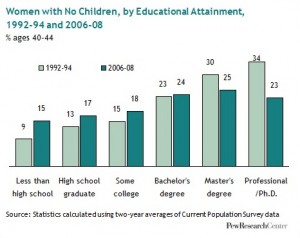
Childless women by educational level – click to enlarge
Graphs: Pew Research Center
In the United States, white women are among all ethnic and racial groups the most likely not to have had a child over the past decade. Over that time period the gap between groups has narrowed with childless rates rising more rapidly for black, Hispanic and Asian women, than for white women. Not surprisingly, women who have never married are most likely to be childless. At the same time, those rates have declined over the past decade and the rate of childlessness has risen for married women and women who were married at one time, according to a recent report from the Pew Research Center.
In 2008, 20 percent or one in every five white women between 40 and 44 years of age was childless. That same year, 17 percent of black and Hispanic women and 16 percent of Asian women in that age group were also without children. Between 1994 and 2008, the rates of childlessness increased more for nonwhites than for whites: the childlessness rates for black women and for Hispanic women went up by more than 30 percent while the increase among white women was 11 percent.

Childless women by race/ethnicity – click to enlarge
This is a sharp contrast to the rates in the 1970s when only 10 percent of white women reached the end of their childbearing years without ever becoming a mother. Although the most educated women are the most likely never to give birth to a child, the exception to the childlessness rates increase was among women with advanced university degrees where the rate fell in the past 10 years. In 2008, 24 percent of women ages 40 to 44 with a master’s, doctoral or professional degree had not had children, a decline from 31 percent in 1994.
The researchers believe childlessness increased for several reasons. Women today endure less social pressure to have children than in past decades. Improved contraceptive methods and better job options for women were also cited as influencing women’s decision to not have children. Women, especially educated women, have delayed marriage and having children, the researchers explain in the report.
Another factor is that some women do not give birth but raise adopted children. In 2008, there were 61.6 million biological children, 1.6 million adopted children and 2.5 million stepchildren in United States homes (2008 American Community Survey).
The report, Childlessness Up Among All Women; Down Among Women with Advanced Degrees, was written by Gretchen Livingston and D’Vera Cohn of the Pew Research Center and released June 25, 2010. They based their findings on Current Population Survey data. The Pew Research Center, a self described nonpartisan provider of information on “the issues, attitudes and trends shaping America and the world.”






















